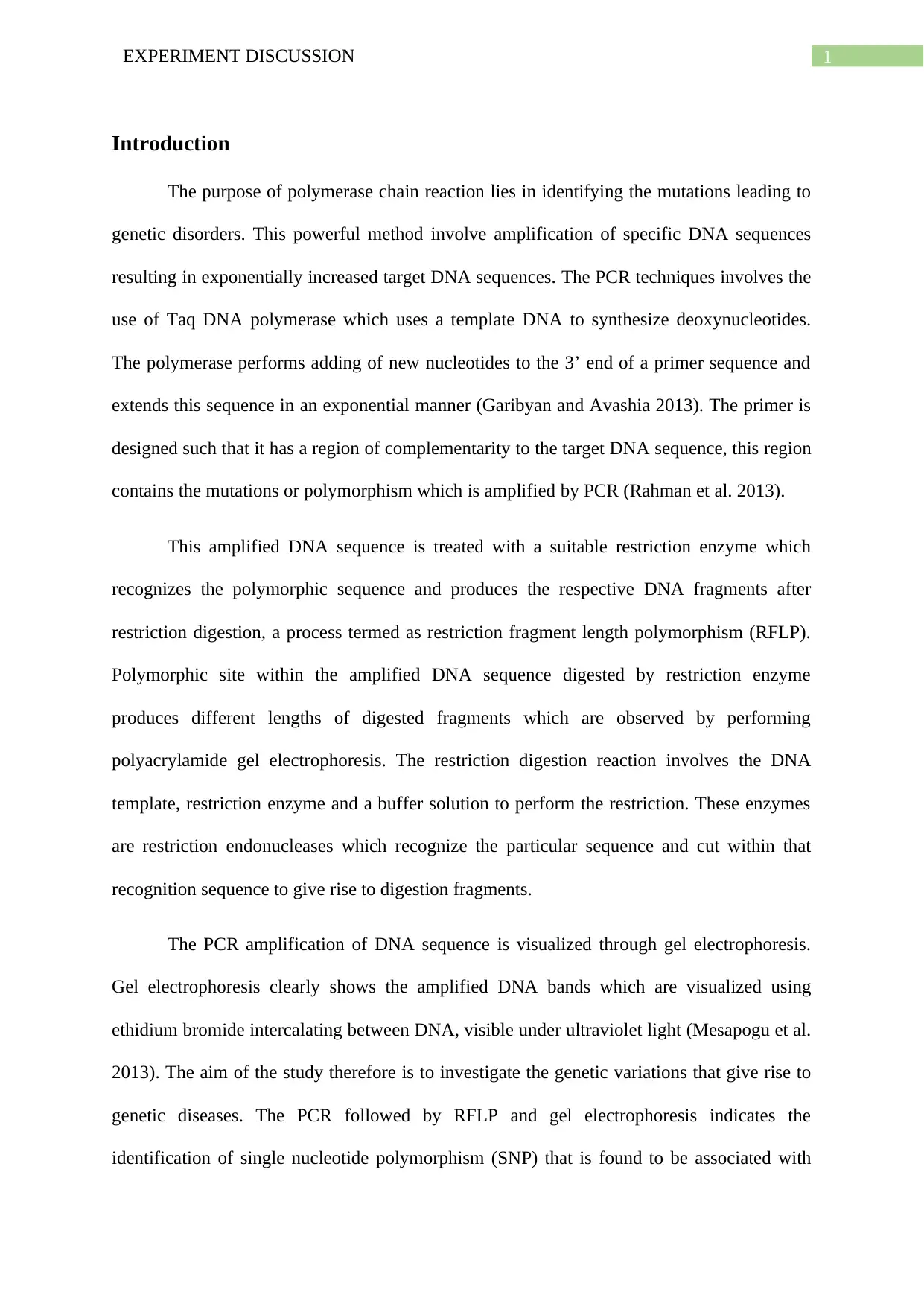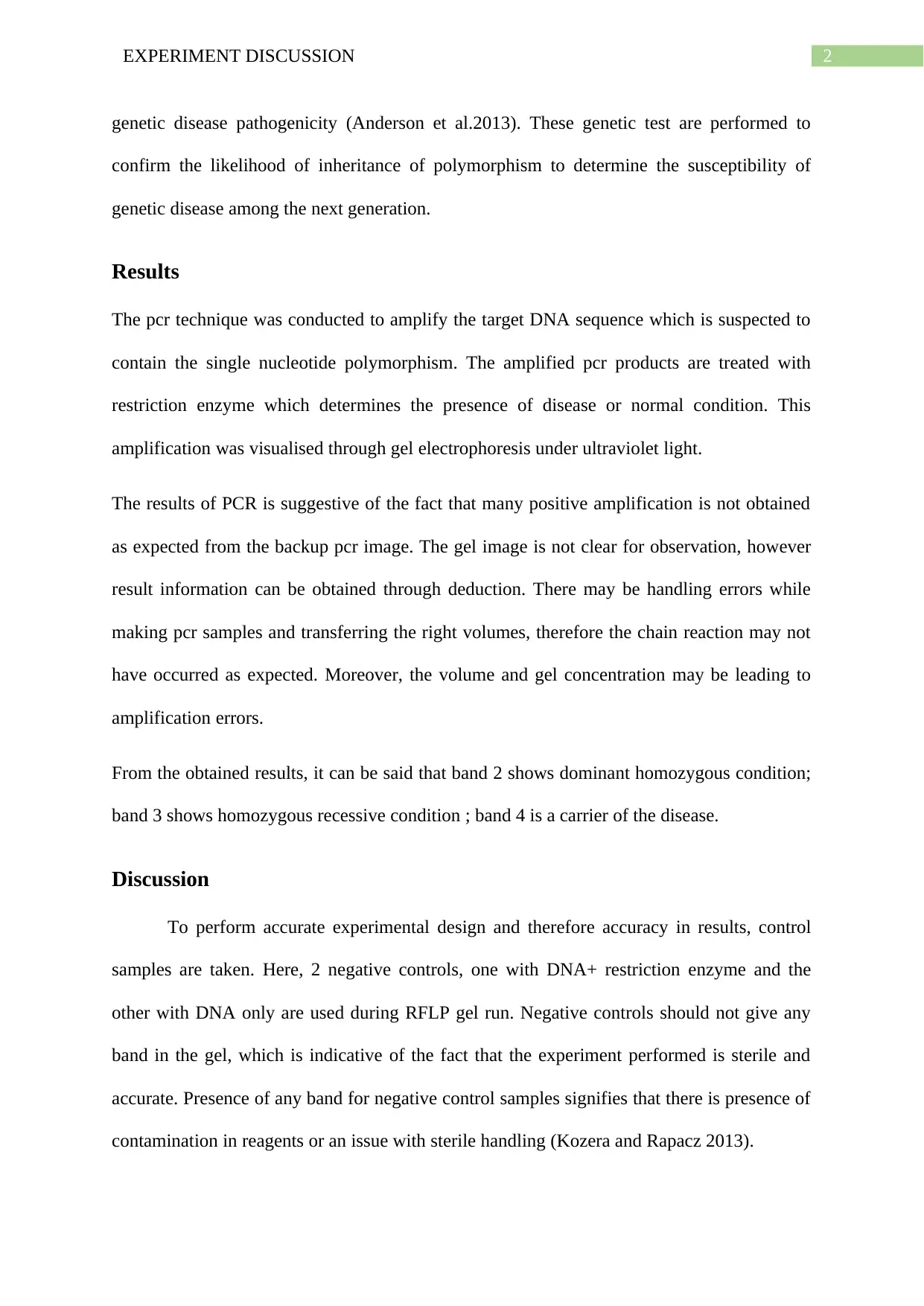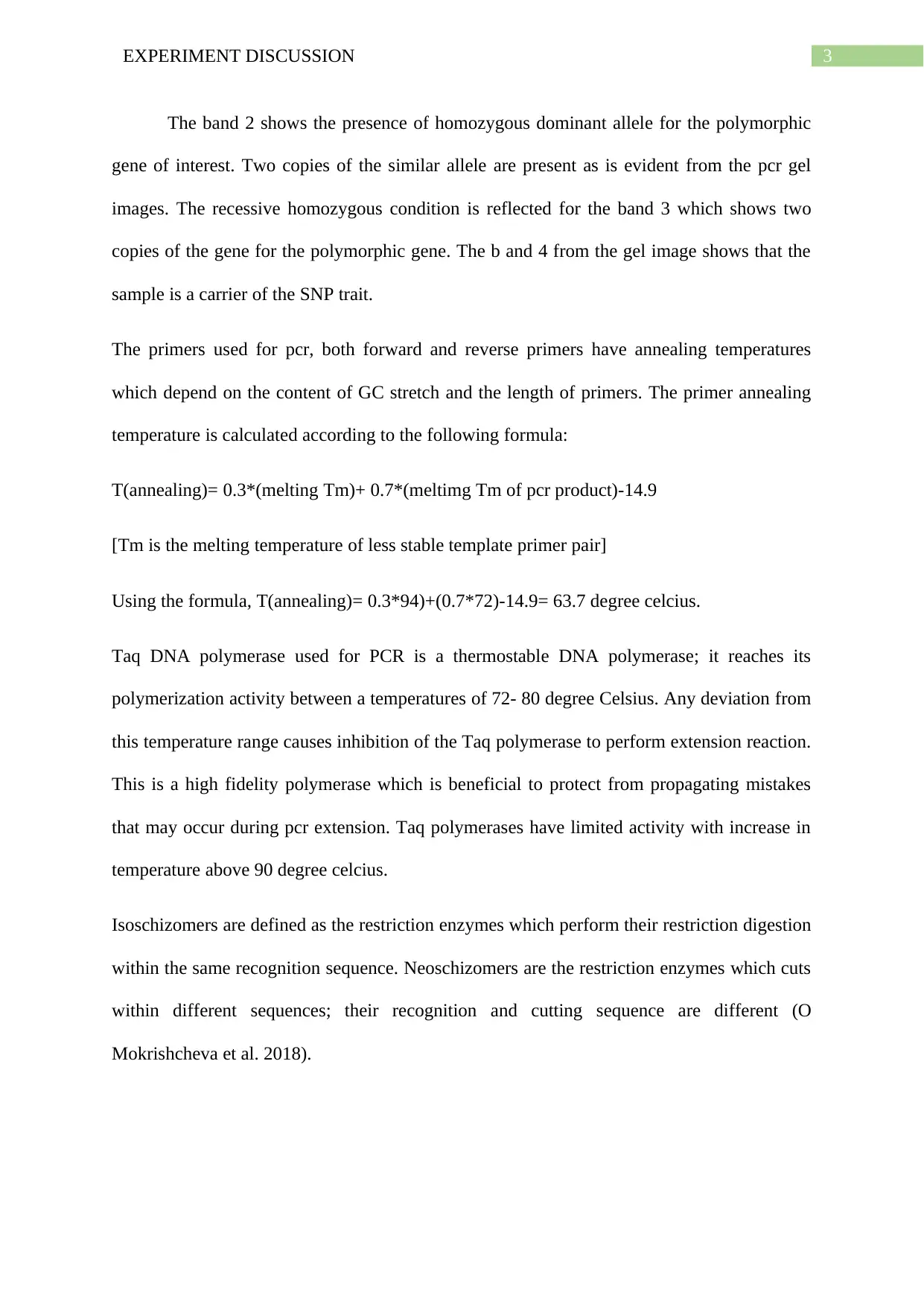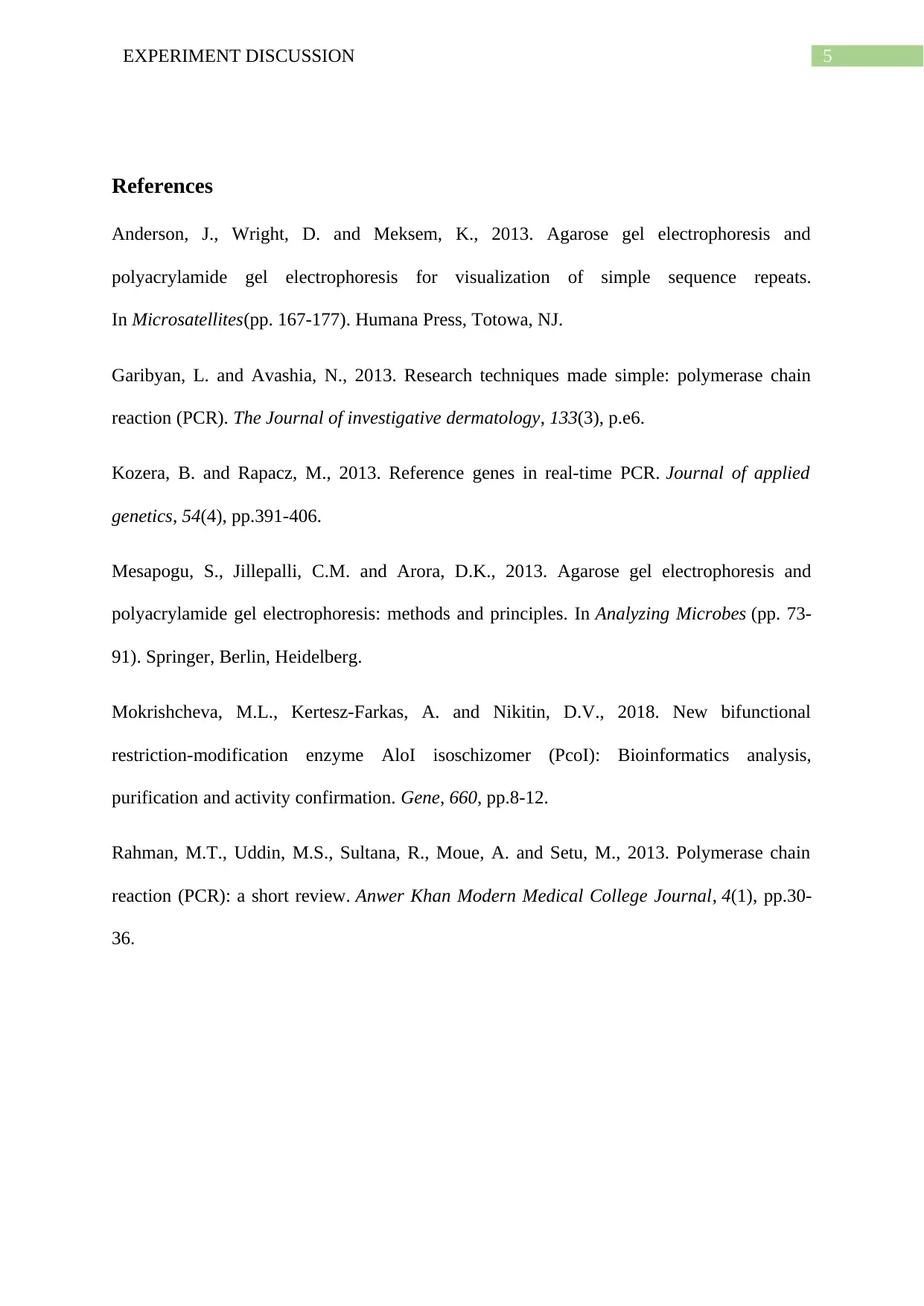BIOM2001: Simulation of Genetic Test for Disease Screening & Analysis
VerifiedAdded on 2023/04/26
|6
|1217
|229
Practical Assignment
AI Summary
This practical assignment simulates a DNA-based genetic test for disease screening, employing PCR, RFLP, and gel electrophoresis. The experiment aims to identify single nucleotide polymorphisms (SNPs) associated with genetic diseases. The process involves amplifying target DNA sequences using PCR, digesting the amplified products with restriction enzymes, and visualizing the resulting fragments via gel electrophoresis. The student discusses the importance of controls, interprets gel results to determine homozygous dominant, homozygous recessive, and carrier conditions, and calculates primer annealing temperatures. Potential sources of error, such as handling mistakes and contamination, are also addressed. The assignment enhances understanding of genetic testing methodologies and SNP identification.

Running head: EXPERIMENT DISCUSSION
Experiment Discussion
Name of student:
Name of university:
Author Note:
Experiment Discussion
Name of student:
Name of university:
Author Note:
Paraphrase This Document
Need a fresh take? Get an instant paraphrase of this document with our AI Paraphraser

1EXPERIMENT DISCUSSION
Introduction
The purpose of polymerase chain reaction lies in identifying the mutations leading to
genetic disorders. This powerful method involve amplification of specific DNA sequences
resulting in exponentially increased target DNA sequences. The PCR techniques involves the
use of Taq DNA polymerase which uses a template DNA to synthesize deoxynucleotides.
The polymerase performs adding of new nucleotides to the 3’ end of a primer sequence and
extends this sequence in an exponential manner (Garibyan and Avashia 2013). The primer is
designed such that it has a region of complementarity to the target DNA sequence, this region
contains the mutations or polymorphism which is amplified by PCR (Rahman et al. 2013).
This amplified DNA sequence is treated with a suitable restriction enzyme which
recognizes the polymorphic sequence and produces the respective DNA fragments after
restriction digestion, a process termed as restriction fragment length polymorphism (RFLP).
Polymorphic site within the amplified DNA sequence digested by restriction enzyme
produces different lengths of digested fragments which are observed by performing
polyacrylamide gel electrophoresis. The restriction digestion reaction involves the DNA
template, restriction enzyme and a buffer solution to perform the restriction. These enzymes
are restriction endonucleases which recognize the particular sequence and cut within that
recognition sequence to give rise to digestion fragments.
The PCR amplification of DNA sequence is visualized through gel electrophoresis.
Gel electrophoresis clearly shows the amplified DNA bands which are visualized using
ethidium bromide intercalating between DNA, visible under ultraviolet light (Mesapogu et al.
2013). The aim of the study therefore is to investigate the genetic variations that give rise to
genetic diseases. The PCR followed by RFLP and gel electrophoresis indicates the
identification of single nucleotide polymorphism (SNP) that is found to be associated with
Introduction
The purpose of polymerase chain reaction lies in identifying the mutations leading to
genetic disorders. This powerful method involve amplification of specific DNA sequences
resulting in exponentially increased target DNA sequences. The PCR techniques involves the
use of Taq DNA polymerase which uses a template DNA to synthesize deoxynucleotides.
The polymerase performs adding of new nucleotides to the 3’ end of a primer sequence and
extends this sequence in an exponential manner (Garibyan and Avashia 2013). The primer is
designed such that it has a region of complementarity to the target DNA sequence, this region
contains the mutations or polymorphism which is amplified by PCR (Rahman et al. 2013).
This amplified DNA sequence is treated with a suitable restriction enzyme which
recognizes the polymorphic sequence and produces the respective DNA fragments after
restriction digestion, a process termed as restriction fragment length polymorphism (RFLP).
Polymorphic site within the amplified DNA sequence digested by restriction enzyme
produces different lengths of digested fragments which are observed by performing
polyacrylamide gel electrophoresis. The restriction digestion reaction involves the DNA
template, restriction enzyme and a buffer solution to perform the restriction. These enzymes
are restriction endonucleases which recognize the particular sequence and cut within that
recognition sequence to give rise to digestion fragments.
The PCR amplification of DNA sequence is visualized through gel electrophoresis.
Gel electrophoresis clearly shows the amplified DNA bands which are visualized using
ethidium bromide intercalating between DNA, visible under ultraviolet light (Mesapogu et al.
2013). The aim of the study therefore is to investigate the genetic variations that give rise to
genetic diseases. The PCR followed by RFLP and gel electrophoresis indicates the
identification of single nucleotide polymorphism (SNP) that is found to be associated with

2EXPERIMENT DISCUSSION
genetic disease pathogenicity (Anderson et al.2013). These genetic test are performed to
confirm the likelihood of inheritance of polymorphism to determine the susceptibility of
genetic disease among the next generation.
Results
The pcr technique was conducted to amplify the target DNA sequence which is suspected to
contain the single nucleotide polymorphism. The amplified pcr products are treated with
restriction enzyme which determines the presence of disease or normal condition. This
amplification was visualised through gel electrophoresis under ultraviolet light.
The results of PCR is suggestive of the fact that many positive amplification is not obtained
as expected from the backup pcr image. The gel image is not clear for observation, however
result information can be obtained through deduction. There may be handling errors while
making pcr samples and transferring the right volumes, therefore the chain reaction may not
have occurred as expected. Moreover, the volume and gel concentration may be leading to
amplification errors.
From the obtained results, it can be said that band 2 shows dominant homozygous condition;
band 3 shows homozygous recessive condition ; band 4 is a carrier of the disease.
Discussion
To perform accurate experimental design and therefore accuracy in results, control
samples are taken. Here, 2 negative controls, one with DNA+ restriction enzyme and the
other with DNA only are used during RFLP gel run. Negative controls should not give any
band in the gel, which is indicative of the fact that the experiment performed is sterile and
accurate. Presence of any band for negative control samples signifies that there is presence of
contamination in reagents or an issue with sterile handling (Kozera and Rapacz 2013).
genetic disease pathogenicity (Anderson et al.2013). These genetic test are performed to
confirm the likelihood of inheritance of polymorphism to determine the susceptibility of
genetic disease among the next generation.
Results
The pcr technique was conducted to amplify the target DNA sequence which is suspected to
contain the single nucleotide polymorphism. The amplified pcr products are treated with
restriction enzyme which determines the presence of disease or normal condition. This
amplification was visualised through gel electrophoresis under ultraviolet light.
The results of PCR is suggestive of the fact that many positive amplification is not obtained
as expected from the backup pcr image. The gel image is not clear for observation, however
result information can be obtained through deduction. There may be handling errors while
making pcr samples and transferring the right volumes, therefore the chain reaction may not
have occurred as expected. Moreover, the volume and gel concentration may be leading to
amplification errors.
From the obtained results, it can be said that band 2 shows dominant homozygous condition;
band 3 shows homozygous recessive condition ; band 4 is a carrier of the disease.
Discussion
To perform accurate experimental design and therefore accuracy in results, control
samples are taken. Here, 2 negative controls, one with DNA+ restriction enzyme and the
other with DNA only are used during RFLP gel run. Negative controls should not give any
band in the gel, which is indicative of the fact that the experiment performed is sterile and
accurate. Presence of any band for negative control samples signifies that there is presence of
contamination in reagents or an issue with sterile handling (Kozera and Rapacz 2013).
⊘ This is a preview!⊘
Do you want full access?
Subscribe today to unlock all pages.

Trusted by 1+ million students worldwide

3EXPERIMENT DISCUSSION
The band 2 shows the presence of homozygous dominant allele for the polymorphic
gene of interest. Two copies of the similar allele are present as is evident from the pcr gel
images. The recessive homozygous condition is reflected for the band 3 which shows two
copies of the gene for the polymorphic gene. The b and 4 from the gel image shows that the
sample is a carrier of the SNP trait.
The primers used for pcr, both forward and reverse primers have annealing temperatures
which depend on the content of GC stretch and the length of primers. The primer annealing
temperature is calculated according to the following formula:
T(annealing)= 0.3*(melting Tm)+ 0.7*(meltimg Tm of pcr product)-14.9
[Tm is the melting temperature of less stable template primer pair]
Using the formula, T(annealing)= 0.3*94)+(0.7*72)-14.9= 63.7 degree celcius.
Taq DNA polymerase used for PCR is a thermostable DNA polymerase; it reaches its
polymerization activity between a temperatures of 72- 80 degree Celsius. Any deviation from
this temperature range causes inhibition of the Taq polymerase to perform extension reaction.
This is a high fidelity polymerase which is beneficial to protect from propagating mistakes
that may occur during pcr extension. Taq polymerases have limited activity with increase in
temperature above 90 degree celcius.
Isoschizomers are defined as the restriction enzymes which perform their restriction digestion
within the same recognition sequence. Neoschizomers are the restriction enzymes which cuts
within different sequences; their recognition and cutting sequence are different (O
Mokrishcheva et al. 2018).
The band 2 shows the presence of homozygous dominant allele for the polymorphic
gene of interest. Two copies of the similar allele are present as is evident from the pcr gel
images. The recessive homozygous condition is reflected for the band 3 which shows two
copies of the gene for the polymorphic gene. The b and 4 from the gel image shows that the
sample is a carrier of the SNP trait.
The primers used for pcr, both forward and reverse primers have annealing temperatures
which depend on the content of GC stretch and the length of primers. The primer annealing
temperature is calculated according to the following formula:
T(annealing)= 0.3*(melting Tm)+ 0.7*(meltimg Tm of pcr product)-14.9
[Tm is the melting temperature of less stable template primer pair]
Using the formula, T(annealing)= 0.3*94)+(0.7*72)-14.9= 63.7 degree celcius.
Taq DNA polymerase used for PCR is a thermostable DNA polymerase; it reaches its
polymerization activity between a temperatures of 72- 80 degree Celsius. Any deviation from
this temperature range causes inhibition of the Taq polymerase to perform extension reaction.
This is a high fidelity polymerase which is beneficial to protect from propagating mistakes
that may occur during pcr extension. Taq polymerases have limited activity with increase in
temperature above 90 degree celcius.
Isoschizomers are defined as the restriction enzymes which perform their restriction digestion
within the same recognition sequence. Neoschizomers are the restriction enzymes which cuts
within different sequences; their recognition and cutting sequence are different (O
Mokrishcheva et al. 2018).
Paraphrase This Document
Need a fresh take? Get an instant paraphrase of this document with our AI Paraphraser

4EXPERIMENT DISCUSSION
This experiment for genetic testing has provided a better understanding of identifying SNP
specific traits of DNA from the patients under study. Clear understanding of heterozygosity,
homozygosity and carrier can be determined from the gel results.
This experiment for genetic testing has provided a better understanding of identifying SNP
specific traits of DNA from the patients under study. Clear understanding of heterozygosity,
homozygosity and carrier can be determined from the gel results.

5EXPERIMENT DISCUSSION
References
Anderson, J., Wright, D. and Meksem, K., 2013. Agarose gel electrophoresis and
polyacrylamide gel electrophoresis for visualization of simple sequence repeats.
In Microsatellites(pp. 167-177). Humana Press, Totowa, NJ.
Garibyan, L. and Avashia, N., 2013. Research techniques made simple: polymerase chain
reaction (PCR). The Journal of investigative dermatology, 133(3), p.e6.
Kozera, B. and Rapacz, M., 2013. Reference genes in real-time PCR. Journal of applied
genetics, 54(4), pp.391-406.
Mesapogu, S., Jillepalli, C.M. and Arora, D.K., 2013. Agarose gel electrophoresis and
polyacrylamide gel electrophoresis: methods and principles. In Analyzing Microbes (pp. 73-
91). Springer, Berlin, Heidelberg.
Mokrishcheva, M.L., Kertesz-Farkas, A. and Nikitin, D.V., 2018. New bifunctional
restriction-modification enzyme AloI isoschizomer (PcoI): Bioinformatics analysis,
purification and activity confirmation. Gene, 660, pp.8-12.
Rahman, M.T., Uddin, M.S., Sultana, R., Moue, A. and Setu, M., 2013. Polymerase chain
reaction (PCR): a short review. Anwer Khan Modern Medical College Journal, 4(1), pp.30-
36.
References
Anderson, J., Wright, D. and Meksem, K., 2013. Agarose gel electrophoresis and
polyacrylamide gel electrophoresis for visualization of simple sequence repeats.
In Microsatellites(pp. 167-177). Humana Press, Totowa, NJ.
Garibyan, L. and Avashia, N., 2013. Research techniques made simple: polymerase chain
reaction (PCR). The Journal of investigative dermatology, 133(3), p.e6.
Kozera, B. and Rapacz, M., 2013. Reference genes in real-time PCR. Journal of applied
genetics, 54(4), pp.391-406.
Mesapogu, S., Jillepalli, C.M. and Arora, D.K., 2013. Agarose gel electrophoresis and
polyacrylamide gel electrophoresis: methods and principles. In Analyzing Microbes (pp. 73-
91). Springer, Berlin, Heidelberg.
Mokrishcheva, M.L., Kertesz-Farkas, A. and Nikitin, D.V., 2018. New bifunctional
restriction-modification enzyme AloI isoschizomer (PcoI): Bioinformatics analysis,
purification and activity confirmation. Gene, 660, pp.8-12.
Rahman, M.T., Uddin, M.S., Sultana, R., Moue, A. and Setu, M., 2013. Polymerase chain
reaction (PCR): a short review. Anwer Khan Modern Medical College Journal, 4(1), pp.30-
36.
⊘ This is a preview!⊘
Do you want full access?
Subscribe today to unlock all pages.

Trusted by 1+ million students worldwide
1 out of 6
Related Documents
Your All-in-One AI-Powered Toolkit for Academic Success.
+13062052269
info@desklib.com
Available 24*7 on WhatsApp / Email
![[object Object]](/_next/static/media/star-bottom.7253800d.svg)
Unlock your academic potential
Copyright © 2020–2025 A2Z Services. All Rights Reserved. Developed and managed by ZUCOL.





